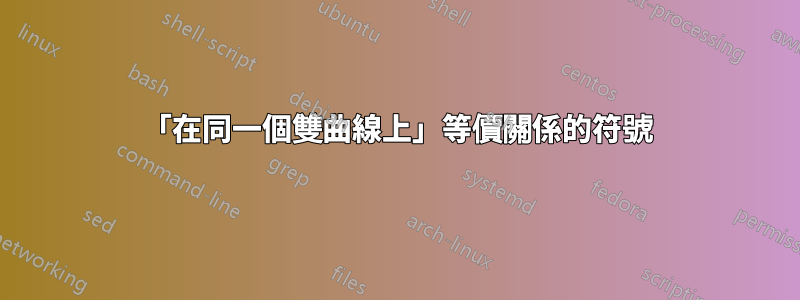
答案1
你的符號有點複雜。由於我不知道標準符號,我建議這樣做:
\asymp它由兩個標準符號(和)疊加而成-,不需要額外的包。 (對我來說)它看起來像\equiv( )的雙曲線版本≡。
\documentclass{article}
\newcommand{\samehyp}{\mathrel{\ooalign{\hfil$\asymp$\hfil\cr\hfil$-$\hfil\cr}}}
\begin{document}
$(a,b)\samehyp(c,d)$
\end{document}
有關如何建立自己的符號的一般說明,我建議這個問題及其答案。
注意:如果您打算使用此符號,\scriptstyle或者\scriptscriptstyle您將需要一個更複雜的版本來適應樣式變更:
\documentclass{article}
%\newcommand{\samehyp}{\mathrel{\ooalign{\hfil$\asymp$\hfil\cr\hfil$-$\hfil\cr}}}
\makeatletter
\newcommand{\samehyp}{\mathrel{\mathpalette\s@mehyp\relax}}
\newcommand{\s@mehyp}[2]{%
\ooalign{%
$\m@th#1\asymp$\cr
\hidewidth$\m@th#1-$\hidewidth\cr
}%
}
\makeatother
\begin{document}
$(a,b)\samehyp(c,d)_{(a,b)\samehyp(c,d)_{(a,b)\samehyp(c,d)}}$
\end{document}
如果您確實想要草繪的符號,您可能必須自己設計。我建議tikz(用於設計符號)並scalerel使其與您選擇的符號(我選擇的+)大小相同。
\documentclass{article}
\usepackage{tikz,scalerel}
\newcommand{\samehyp}{\mathrel{\scalerel*{\tikz{\draw[line width=2pt](0,.3)--(1,.3)(0,.5)--(1,.5)(0,.7)--(1,.7)(.6,1)to[out=-90,in=180](1,.6)(.4,0)to[out=90,in=0](0,.4);}}{+}}}
\begin{document}
$(a,b)\samehyp(c,d)$
\end{document}






